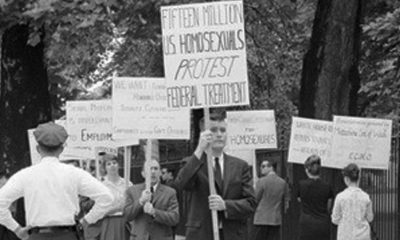Arts & Entertainment
From music to fashion, catching up with Steve Grand
‘All American Boy’ now focused on his clothing brand

What’s the first thing that comes to mind when you think of gay singer/songwriter turned fashion designer Steve Grand? Some folks will undoubtedly answer his breakout hit single, “All American Boy,” and the accompanying video. Both were significant in that the song was an unabashedly queer country tune with visuals to match. Of course, it didn’t hurt that Grand was model-handsome and had a flawless body on display. So far, we have his singing voice, songwriting chops, and impressive looks and physique. It’s that gym body, and his own personal interest in the kinds of garments that show them off, that has led him to create his Grand Axis (shopGrandAxis.com) clothing line, featuring men’s underwear and swimwear. Steve was kind enough to make time for an interview, and after you finish reading it, you’ll want to follow him on his socials: @GrandAxis (Instagram), @GrandAxis (TikTok), and @Grand_Axis (Twitter). You won’t be disappointed.
BLADE: Since the release of your debut single in 2013, the country-oriented “All American Boy,” several other male country artists, including Ty Herndon, Billy Gilman, Orville Peck, and TJ Osborne have come out as gay. Do you feel that your being an out musician had anything to do with that?
STEVE GRAND: I think, more than anything, it had to do with the major cultural shift that was happening across this country. According to the Gallup polls, public support for gay marriage went from 40% approval in May 2009, to 60% approval in May 2015. Gay marriage was a big topic of discussion in the early 2010s for a lot of reasons. You had artists like (Lady) Gaga frequently talking about her gay fans, you had gay characters coming out in TV shows; you had the repeal of “Don’t Ask Don’t Tell” in 2011, and then Obergefell in 2015. I think the internet, and the rise of social media had more to do with it than anything. Before social media, corporate press and big movie and TV studios drove the narrative on these sorts of things. And because they are beholden to advertisers, which are more conservative and risk-averse, they would often avoid even acknowledging LGBTQ+ people for fear it would upset large sections of the country. But I think social media gave regular people an opportunity to be their authentic selves. And it gave artists/content creators like me the ability to make music and videos that could be seen by millions without needing the backing of a big record label.
BLADE: Almost 10 years ago, in 2015, you released your full-length debut album “All American Boy.” When you look back on that time, how would you describe it?
GRAND: It was a whirlwind. I remember being cognizant of the fact that it was all moving fast and that I needed to make a conscious effort to stop and take in all the cool, special, unique experiences I was having. Looking back, I don’t think I listened to that voice inside me enough. I always felt like my best days were ahead; that my moment had yet to come, and that I just needed to hunker down and keep working. And, unfortunately, that often kept me from embracing the present moment.
It’s funny, my best memories of that time end up being all the times in between, like the road trips with my tour manager and whatever members of the band I was traveling with. I was always thinking about what I needed to be doing better or focused on the show, but it is those conversations on the road when we were tired, hungover, and stressing about where we needed to be, traveling from one venue to the next, that I remember most fondly.
BLADE: What kind of music are you listening to for enjoyment these days?
GRAND: I am loving the new Billie Eilish record. And the country record Post Malone just made. I continue to appreciate him more and more. Whenever I see him in interviews I am just so impressed with how centered and genuine he is; how he seems to know exactly who he is. There is a real depth and a goodness in him, and I think that really comes through in his voice.
BLADE: Am I remembering correctly that for a while, you left Chicago for LA? If that’s correct, what was that experience like for you?
GRAND: I spent some time in LA while I was making my first record. I stayed with a friend of a friend. Funny enough, I had never met them before the day I showed up at their door with my bags. It was on my 24th birthday. They gave and gave to me and never expected anything in return. I don’t think I ever went out and did any nightlife there. The friends I stayed with had a large group of friends and threw a lot of parties and events, so I really benefited from having their sort of built-in group of guys to hang out with when I stayed out there.
BLADE: How long have you been back in Chicago?
GRAND: Other than the several months I’ve spent in LA, my summers in Ptown, and winters in Puerto Vallarta, I’ve been in the Chicago area the whole time.
BLADE: What do you like best about being in Chicago?
GRAND: The lakefront in the summer. The fact that the crumby winters are something we all endure together, which means we also experience the beauty and aliveness of the spring and summer together. The winters are so cold and dead, but it makes you appreciate the beautiful weather in the summer, and all the plant life that comes back to life. The whole city comes alive when it starts getting nice. Everyone’s mood is lifted and there is a real sense that we need to make the most of the summer because it’s fleeting. I also love the people. Chicago is not as transient as cities like LA and New York where most people are not from there. Most Chicagoans have roots here. And people are genuinely nice and kind.
BLADE: In 2019, you launched Grand Axis, a clothing line designed by you that includes underwear, swimwear, shorts, socks, T-shirts, and hats. How did you come up with the name Grand Axis?
GRAND: I was about two weeks from going into production with the name “Grand.” I stupidly assumed I could use it because it was my name, but decided I should hire a trademark attorney just to be sure. I was told there were about 200 other companies that could have a copyright infringement claim, so I needed to come up with a name very quickly. I used word generators and all sorts of other methods of coming up with names. I went with “Axis” because I just like how it sounded together; I thought the word “Axis” was very strong, and I liked that it had the letter X in it, which just looks cool and strong.
BLADE: Was designing this kind of clothing a lifelong passion of yours, or was it something you stumbled upon and decided to run with it?
GRAND: Like a lot of gay men, I had my sexual awakening in the men’s underwear aisle at our local department store [laughs]. And personally, I’ve always found an attractive guy in a Speedo, briefs, or jockstrap even more sexy than seeing him naked. Even when I was a college student working a $10 an hour job and didn’t even have many regular clothes, I was buying more of this attire for myself than anything else. I started to get very fixated on the design and fit. I didn’t know how to sew, but I learned enough to make basic alterations to design and fit. Then I found some sites that made custom pieces. I began drawing my own patterns and having them sewn up. When I posted them on Instagram, I’d get lots of guys asking where they could buy them. And at that point I decided I should just produce them en masse. I thought it would be a side gig. I had no idea all that was involved. I think if I knew how hard it would be I may not have started it [laughs]! So, my ignorance kind of worked out to my benefit, because now I am deep in it and I’m happy I made it all work. So far at least.
BLADE: What’s the most rewarding part of Grand Axis?
GRAND: Going to the beach and seeing guys I don’t even know wearing my brand! It is so rewarding to see guys enjoying and looking great in something I spent hundreds of hours obsessing over every detail. That makes it all so worth it.
BLADE: What’s the most challenging part?
GRAND: A few things: Delegating. Dealing with factories to get them to make the pieces exactly how I want. Always having to make decisions about every aspect of the products and the business. The stress of wiring tens of thousands of dollars of my own money before I see any product. At the end of the day, if the factory goes under, you really don’t have any recourse. I’ve heard horror stories from other brands.
BLADE: You shared your recent pec tear workout injury, as well as your recovery, on social media. Are you fully back to 100% or still taking it easy?
GRAND: I am very grateful to be able to say recovery has been easy and painless. I had an excellent surgeon. The first surgeon I saw said it could not be repaired so I am very glad I got a second opinion. The worst part has been not being able to move much weight with it. There are so many exercises I can’t do, I’m afraid to say I have only had a handful of workouts in the last 10 weeks. I will be 75% healed at 12 weeks, but it will still be a few months before I can lift heavy. But in the scheme of things, I am just grateful I had a problem that could be fixed.
BLADE: Your second album, “Not The End of Me” was released in 2018. Because most people came to know you as a singer/songwriter first, I’d be remiss if I didn’t ask if there was more music from you in the works.
GRAND: I still will write music, but most songs are incomplete. I wish I could say I had another record ready to go, but when the pandemic happened and I wasn’t able to perform and lost 90% of my income that year, I had to make Grand-Axis my full-time job to pay the bills. And now that it has, I struggle to find the time and creative energy to make that happen. But I am still hopeful I will get back to it one of these days.
Bars & Parties
Mixtape Sapphics hosts holiday party on Dec. 13
‘Sugar & Spice’ night planned for Saturday

Mixtape Sapphics will host “Sapphic Sugar & Spice: A Naughty-Nice Mixtape Holiday Party” on Saturday, Dec. 13 at 4 p.m. at Amsterdam Lounge.
This is a festive, grown holiday party for queer women and sapphics 35 and older at Revolt’s Christmas pop-up. There will be music, joy, and an optional White Elephant.
This is Mixtape Sapphics’ first-ever holiday party — a cozy, flirty, intentionally grounded night created just for queer women and sapphics 35+ who want real connection, festive joy, and a warm place to land at the end of the year.
Tickets start at $13.26 and can be purchased on Eventbrite.

Friday, December 12
“Center Aging Friday Tea Time” will be at 12 p.m. in person at the DC Center for the LGBT Community’s new location at 1827 Wiltberger St., N.W. To RSVP, visit the DC Center’s website or email [email protected].
Go Gay DC will host “LGBTQ+ Community Happy Hour” at 7 p.m. at Freddie’s Beach Bar and Restaurant. This event is ideal for making new friends, professional networking, idea-sharing, and community building. This event is free and more details are available on Eventbrite.
Women in Their Twenties and Thirties will be at 8 p.m. on Zoom. This is a social discussion group for queer women in the Washington, D.C. area. For more details, go to Facebook.
Saturday, December 13
Go Gay DC will host “LGBTQ+ Community Brunch” at 12 p.m. at Freddie’s Beach Bar & Restaurant. This fun weekly event brings the DMV area LGBTQ+ community, including allies, together for delicious food and conversation. Attendance is free and more details are available on Eventbrite.
The DC Center for the LGBT Community will host “Sunday Supper on Saturday” at 2 p.m. D.C.’s queer community will gather for good food, laughter, and community. For more information, email [email protected].
Sunday, December 14
SADBrunch will host “HokiSlay Drag Brunch” at 12 p.m. at Throw Social. This festive affair brings fierce performances, over-the-top holiday looks, and more sparkle than a tinsel explosion. Expect powerhouse lip-syncs, laughter, and cheer hotter than your spiked cocoa. Cake Pop will host the event. Tickets cost $28.52 and are available on Eventbrite.
Monday, December 15
“Center Aging: Monday Coffee Klatch” will be at 10 a.m. on Zoom. This is a social hour for older LGBTQ+ adults. Guests are encouraged to bring a beverage of choice. For more information, contact Adam ([email protected]).
Genderqueer DC will be at 7 p.m. on Zoom. This is a support group for people who identify outside of the gender binary, whether you’re bigender, agender, genderfluid, or just know that you’re not 100% cis. For more details, visit genderqueerdc.org or Facebook.
Tuesday, December 16
Center Bi+ Roundtable will be at 7 p.m. on Zoom. This is an opportunity for people to gather and discuss issues related to bisexuality or as Bi individuals in a private setting. Visit Facebook or Meetup for more information.
The DC Center for the LGBT Community will host “Self-Defense Class with Avi Rome” at 12:30 p.m. Rome is a proud member of the LGBTQ community and a full-time martial arts instructor with 25 years of teaching experience. He holds a Fifth Degree Black Belt in Jhoon Rhee Tae Kwon Do and is the director of the studio’s Adaptive Tae Kwon Do program for students with special needs. He has also run numerous self-defense workshops for various groups and situations. For more details, visit the center’s website.
Wednesday, December 17
Job Club will be at 6 p.m. on Zoom upon request. This is a weekly job support program to help job entrants and seekers, including the long-term unemployed, improve self-confidence, motivation, resilience and productivity for effective job searches and networking — allowing participants to move away from being merely “applicants” toward being “candidates.” For more information, email [email protected] or visit thedccenter.org/careers.
Asexual and Aromantic Group will be at 7 p.m. on Zoom. This is a space where people who are questioning this aspect of their identity or those who identify as asexual and/or aromantic can come together, share stories and experiences, and discuss various topics. For more details, email [email protected].
Thursday, December 18
The DC Center’s Fresh Produce Program will be held all day at the DC Center for the LGBT Community. People will be informed on Wednesday at 5 p.m. if they are picked to receive a produce box. No proof of residency or income is required. For more information, email [email protected] or call 202-682-2245.
Virtual Yoga Class will be at 7 p.m. on Zoom. This free weekly class is a combination of yoga, breath work and meditation that allows LGBTQ+ community members to continue their healing journey with somatic and mindfulness practices. For more details, visit the DC Center’s website.
Egypt
Iran, Egypt object to playing in Seattle World Cup ‘Pride Match’
Game to take place on June 26

Iran and Egypt have objected to playing in a “Pride Match” that will take place in Seattle during the 2026 World Cup.
The Egyptian Football Association on Tuesday said it told FIFA Secretary General Mattias Grafström in a letter that “it categorically rejects holding any activities related to supporting (homosexuality) during the match between the Egyptian national team and Iran, scheduled to be held in Seattle, USA, on June 26, 2026, in the third round of the group stage of the 2026 World Cup.” Football Federation Islamic Republic of Iran President Mehdi Taj told ISNA, a semi-official Iranian news agency that both his country and Egypt “protested this issue.”
The 2026 World Cup will take place in the U.S., Canada, and Mexico. The draw took place at the Kennedy Center on Dec. 5.
Iran is among the handful of countries in which consensual same-sex sexual relations remain punishable by death.
The State Department’s 2023 human rights report notes that while Egyptian law “did not explicitly criminalize consensual same-sex sexual activity, authorities regularly arrested and prosecuted LGBTQI+ persons on charges including ‘debauchery,’ prostitution, and ‘violating family values.’” Egyptian authorities “also reportedly prosecuted LGBTQI+ individuals for ‘misuse of social media.’”
“This resulted in de facto criminalization of same-sex conduct and identity,” notes the report.
The 2024 human rights report the State Department released earlier this year did not include LGBTQ-specific references.
Soccer has ‘unique power to unite people across borders, cultures, and beliefs’
The June 26 match between Iran and Egypt coincides with Seattle Pride. The Washington Post reported the Seattle FIFA World Cup 2026 Local Organizing Committee decided to hold the “Pride Match” before last week’s draw.
“As the Local Organizing Committee, SeattleFWC26’s role is to prepare our city to host the matches and manage the city experience outside of Seattle Stadium,” said SeattleFWC26 Vice President of Communications Hana Tadesse in a statement the committee sent to the Washington Blade on Wednesday. “SeattleFWC26 is moving forward as planned with our community programming outside the stadium during Pride weekend and throughout the tournament, partnering with LGBTQ+ leaders, artists, and business owners to elevate existing Pride celebrations across Washington.”
“Football has a unique power to unite people across borders, cultures, and beliefs,” added Tadeese. “The Pacific Northwest is home to one of the nation’s largest Iranian-American communities, a thriving Egyptian diaspora, and rich communities representing all nations we’re hosting in Seattle. We’re committed to ensuring all residents and visitors experience the warmth, respect, and dignity that defines our region.”
The 2034 World Cup will take place in Saudi Arabia.
Consensual same-sex sexual relations remain punishable by death in the country. The 2022 World Cup took place in neighboring Qatar, despite concerns over the country’s anti-LGBTQ rights record.
-

 Congress1 day ago
Congress1 day agoEXCLUSIVE: George Santos speaks out on prison, Trump pardon, and more
-

 Health4 days ago
Health4 days agoThe harsh truth about HIV phobia in gay dating
-

 Arts & Entertainment5 days ago
Arts & Entertainment5 days agoCynthia Erivo, Eva Victor, and ‘Blue Moon’ bring queer representation to Golden Globe film nominations
-

 Spain3 days ago
Spain3 days agoVictory Institute honors transgender Spanish senator in D.C.




















